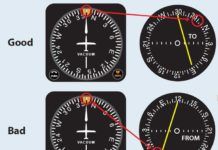When Reverse Sensing Already Is
Many pilots struggle to properly use an HSI when flying a localizer. If youre inbound to a VOR on a given course, pass the station and proceed outbound, you dont change the OBS, right? Likewise, when outbound on a localizer, dont change the OBS, HSI or not. So, similarly, if youre flying the front course-inbound or past the runway-you select the front course by convention for situational awareness, even though a localizer doesnt care where the OBS is.
Trust, but Verify
A number of years ago a friend called to tell me his chilling tale of a low-IFR departure in his turboprop. Shortly after takeoff, the controller warned him of an impending collision with a mountain range two miles ahead.
HSI Tech
While the HSI was a game-changer for the instrument pilot by raising the bar on situational awareness, it introduced more avionics complexity, especially when connected to multiple nav sources. In failure mode, and for the pilot who doesnt know how to operate it, the instrument can be a killer. When I was a new avionics technician, Narcos DGO-series HSI system was the ground breaker. But, not all pilots fully understood what an HSI would do, and fewer yet understood how they worked. Thats somewhat true even today.
Timing Strategies
How many timers do you have in your aircraft? With installed timers and clocks, portable devices, watches and that old instrument training timer living in the bottom of your flight bag, you likely several more than you might realize. Not all of them are convenient or necessary, but its interesting to note that in this age of satellite navigation, moving maps and data pages, timers remain ubiquitous. The sweet spot for good utility is probably three: One for flight time, one for fuel tanks or other procedures, and one for approach procedures. Some timing devices allow you to monitor all three together. Whatever your preference, you have choices.
Keeping Time
The trusty digital timer is a fixture in IFR training. You learned to time your turns, your flight segments, holds and approaches. You learned to keep an eye on your arrival times, lest you run late and need to inform ATC. Lately, though, the practice of timing approaches and related operations has largely gone by the wayside with the use of GPS navigators. With your flight plan laid out and the ETA for each upcoming fix displayed nicely on your screen, few pilots bother to separately use a timer. And, lets face it: Timer use for navigation is solely a backup if youve got GPS and a moving map.
The Drones are Coming Here
A tiny aircraft, too small to carry a person, flashes past your left wing. You never saw it; neither did ATC. You just had a near miss with a drone.There are large, heavy commercial and military drones capable of flying in the flight levels. Then, there are little drones that range from toys up to Amazons proposed single-package delivery device. While similar, each presents different challenges.
GPS Holds
A longstanding corollary to Murphys Law asserts that Interchangeable parts wont. So it is when we set out to compare conventional holds to GPS holds. In some respects they can be quite different, and the subtle GPS differences can become suddenly important. Here, then are the ins-and-outs of flying GPS holds.Consider that there are three phases to any hold: the entry, the execution and maintaining the established hold. I call them the three Es. Lets scrutinize each phase from both conventional and GPS perspectives, then apply that knowledge to some GPS navigators. But, before we dig into that, lets take a closer look at the difference between a GPS (DME) hold and a conventional holding pattern.
VOR Survival Tricks
Well state right up front that flying IFR these days without even a portable GPS is just foolish. No matter how good your VOR skills might be, if you get that kind of situational awareness and backup in a used GPS for the cost of two tanks of avgas in a Cessna 172, why wouldnt you fly with one?That said, neither our GPS-and-WAAS satellite constellation, nor a $16,000 IFR-GPS navigator, is bulletproof. And even when you happily supplement your /U or /A status with a portable GPS, batteries die, screens fail and sometimes its easier to employ a few knob-twisting tricks rather than struggle to input the name of an unanticipated fix while trying to keep it all upright in turbulence. So (maybe for the last time in the run of this magazine) here are some of those VOR tips and techniques you may have forgotten. You never know when they might come in handy.
Things Were Forced to Do
My friends with high-performance engines will probably stop returning my phone calls for a few months after I say this, but its finally time for the EPA to push getting the lead out of avgas. And, no, I dont believe its time because our aviation lead is poisoning the brains of squirrels and small children who live under approach paths. Lead isnt healthy for anyone, but were probably too small a source to make that much difference.
Just in Case Youve Forgotten …
If your heading matches a value in the top half of the OBS, then you have correct sensing and To/From indications.
Just in Case Youve Forgotten …
If your heading matches a value in the top half of the OBS, then you have correct sensing and To/From indications.
Jepp Users Have the Best Digital Plate Reader So Far
Anyone who has hauled around the paper approach plates for more than a couple U.S. states has wished for a better way. It seems like a digital reader should be a no-brainer, but getting the size, weight, navigation and readability right turns out to be a tough nut to crack.
















